Beko DNE 26020, DNE 26000 User Manual [ru]

DNE 26000
DNE 26000 M
DNE 26000 S
DNE 26020
DNE 26020 S
Refrigerator
Šaldytuvas
Холодильник
Hladilnik
Please read this manual first!
Dear Customer,
We hope that your product, which has been produced in modern plants and checked under the most meticulous quality control procedures, will provide you an effective service.
For this, we recommend you to carefully read the entire manual of your product before using it and keep it at hand for future references.
This manual
•Will help you use your appliance in a fast and safe way.
•Read the manual before installing and operating your product.
•Follow the instructions, especially those for safety.
•Keep the manual in an easily accessible place as you may need it later.
•Besides, read also the other documents provided with your product. Please note that this manual may be valid for other models as well.
Symbols and their descriptions
This instruction manual contains the following symbols:
C
A Warning against dangerous conditions for life and property.
B Warning against electric voltage.

CONTENTS
1 Your refrigerator |
3 |
2 Important Safety |
|
Warnings |
4 |
Intended use...................................... |
4 |
For products with a water dispenser;. 6 |
|
Child safety........................................ |
6 |
Compliance with WEEE Directive and |
|
Disposing of the Waste Product: ....... |
6 |
Compliance with RoHS Directive:....... |
6 |
Package information.......................... |
6 |
HCA Warning..................................... |
7 |
Things to be done for energy saving... |
7 |
Recommendations for freshfood |
|
compartment..................................... |
8 |
3 Installation |
9 |
Points to be considered when re- |
|
transporting your refrigerator.............. |
9 |
Before operating your refrigerator....... |
9 |
Disposing of the packaging.............. |
10 |
Disposing of your old refrigerator...... |
10 |
Placing and Installation..................... |
10 |
Adjusting the feet............................. |
11 |
Open door warning.......................... |
11 |
Changing the illumination lamp ........ |
11 |
Reversing the doors......................... |
12 |
4 |
Preparation |
13 |
5 |
Using your refrigerator 14 |
|
Fridge compartment thermostat setting |
||
button ............................................. |
14 |
|
Freezer compartment thermostat |
|
|
setting button .................................. |
15 |
|
Making ice........................................ |
15 |
|
Freezing fresh food........................... |
16 |
|
Recommendations for preservation of |
||
frozen food....................................... |
16 |
|
Placing the food............................... |
17 |
|
Deep-freeze information................... |
17 |
|
6 |
Maintenance and |
|
cleaning |
18 |
|
Protection of plastic surfaces .......... |
18 |
|
7 |
Recommended solutions |
|
for the problems |
19 |
|
2 EN

1 Your refrigerator
131 
*2 


3 


*4 
5 
4 


144 
6 


*7


8
*9
*12
10
*11
11
11
*12
1. |
Freezer compartment shelf |
8. |
Adjustable legs |
2. |
Ice container |
9. |
Freezer compartment door shelf |
3. |
Fridge compartment temperature |
10. |
Egg tray |
|
setting button |
11. |
Fridge compartment door shelf |
4. |
Adjustable body shelves |
12. |
Key |
5. |
Illumination lens |
13. |
Freezer compartment |
6. |
Crisper cover |
14. |
Fridge compartment |
7. |
Crisper |
* OPTIONAL |
|
Figures that take place in this instruction manual are schematic and may not correspond exactly with your product. If the subject parts are not included in the product you have purchased, then it is valid for other models.
3 EN

|
Important Safety Warnings |
||
2 |
|||
|
|
|
|
Please review the following information. |
• For products with a freezer |
||
Failure to observe this information may |
compartment; Do not put bottled and |
||
cause injuries or material damage. |
|||
canned liquid beverages in the freezer |
|||
Otherwise, all warranty and reliability |
|||
compartment. Otherwise, these may |
|||
commitments will become invalid. |
|||
burst. |
|||
The usage life of the unit you purchased |
|||
• Do not touch frozen food by hand; |
|||
is 10 years. This is the period for |
they may stick to your hand. |
||
keeping the spare parts required for the |
• Unplug your refrigerator before |
||
unit to operate as described. |
cleaning or defrosting. |
||
Intended use |
• Vapor and vaporized cleaning |
||
materials should never be used in |
|||
This product is intended to be used |
cleaning and defrosting processes of |
||
• indoors and in closed areas such as |
your refrigerator. In such cases, the |
||
homes; |
vapor may get in contact with the |
||
• in closed working environments such |
electrical parts and cause short circuit |
||
as stores and offices; |
or electric shock. |
||
• in closed accommodation areas such |
• Never use the parts on your |
||
as farm houses, hotels, pensions. |
refrigerator such as the door as a |
||
• This product should not be used |
means of support or step. |
||
outdoors. |
• Do not use electrical devices inside |
||
|
|
the refrigerator. |
|
General safety |
• Do not damage the parts, where |
||
• When you want to dispose/scrap the |
the refrigerant is circulating, with |
||
product, we recommend you to consult |
drilling or cutting tools. The refrigerant |
||
the authorized service in order to learn |
that might blow out when the gas |
||
the required information and authorized |
channels of the evaporator, pipe |
||
bodies. |
extensions or surface coatings are |
||
• Consult your authorized service for all |
punctured causes skin irritations and |
||
your questions and problems related to |
eye injuries. |
||
the refrigerator. Do not intervene or let |
• Do not cover or block the ventilation |
||
someone intervene to the refrigerator |
holes on your refrigerator with any |
||
without notifying the authorised |
material. |
||
services. |
• Electrical devices must be repaired |
||
• For products with a freezer |
by only authorised persons. Repairs |
||
compartment; Do not eat cone ice |
performed by incompetent persons |
||
cream and ice cubes immediately |
create a risk for the user. |
||
after you take them out of the freezer |
• In case of any failure or during |
||
compartment! (This may cause frostbite |
a maintenance or repair work, |
||
in your mouth.) |
disconnect your refrigerator’s mains |
||
supply by either turning off the relevant fuse or unplugging your appliance.
4 EN
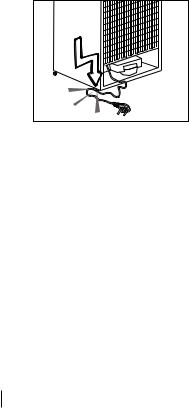
•Do not pull by the cable when pulling off the plug.
•Place the beverage with higher proofs tightly closed and vertically.
•Never store spray cans containing flammable and explosive substances in the refrigerator.
•Do not use mechanical devices or other means to accelerate the
defrosting process, other than those recommended by the manufacturer.
•This product is not intended to be used by persons with physical, sensory or mental disorders or unlearned or inexperienced people (including children) unless they are attended by a person who will be responsible for their safety or who will instruct them accordingly for use of the product
•Do not operate a damaged refrigerator. Consult with the service agent if you have any concerns.
•Electrical safety of your refrigerator shall be guaranteed only if the earth system in your house complies with standards.
•Exposing the product to rain, snow, sun and wind is dangerous with respect to electrical safety.
•Contact authorized service when there is a power cable damage to avoid danger.
•Never plug the refrigerator into the wall outlet during installation. Otherwise, risk of death or serious injury may arise.
•This refrigerator is intended for only storing food items. It must not be used for any other purpose.
•Label of technical specifications is located on the left wall inside the refrigerator.
•Never connect your refrigerator to electricity-saving systems; they may damage the refrigerator.
•If there is a blue light on the refrigerator, do not look at the blue light with optical tools.
•For manually controlled refrigerators, wait for at least 5 minutes to start the refrigerator after power failure.
•This operation manual should be handed in to the new owner of the product when it is given to others.
•Avoid causing damage on power cable when transporting the refrigerator. Bending cable may cause fire. Never place heavy objects on power cable. Do not touch the plug with wet hands when plugging the product.
•Do not plug the refrigerator if the wall outlet is loose.
•Water should not be sprayed directly on inner or outer parts of the product for safety purposes.
•Do not spray substances containing inflammable gases such as propane gas near the refrigerator to avoid fire and explosion risk.
•Never place containers filled with water on top of the refrigerator, otherwise this may cause electric shock or fire.
5 EN

•Do not overload your refrigerator with excessive amounts of food. If overloaded, the food items may fall down and hurt you and damage refrigerator when you open the door. Never place objects on top of the refrigerator; otherwise, these objects may fall down when you open or close the refrigerator's door.
•As they require a precise temperature, vaccines, heat-sensitive medicine and scientific materials and etc. should not be kept in the refrigerator.
•If not to be used for a long time, refrigerator should be unplugged. A possible problem in power cable may cause fire.
•The plug's tip should be regularly cleaned; otherwise, it may cause fire.
•The plug’s tip should be cleaned regularly with a dry cloth; otherwise, it may cause fire.
•Refrigerator may move if adjustable legs are not properly secured on the floor. Properly securing adjustable legs on the floor can prevent the refrigerator to move.
•When carrying the refrigerator, do not hold it from door handle. Otherwise, it may be snapped.
•When you have to place your product next to another refrigerator or freezer, the distance between devices should be at least 8cm. Otherwise, adjacent side walls may be humidified.
For products with a water dispenser;
Pressure of water mains should be minimum 1 bar. Pressure of water mains should be maximum 8 bars.
• Use only potable water.
6
Child safety
•If the door has a lock, the key should be kept away from reach of children.
•Children must be supervised to prevent them from tampering with the product.
Compliance with WEEE Directive and Disposing of the Waste Product:
This product complies with EU WEEE
Directive (2012/19/EU). This
product bears a classification symbol for
waste electrical and electronic equipment
(WEEE).This product has been manufactured with
high quality parts and materials which can be reused and are suitable for recycling. Do not dispose of the waste product with normal domestic and other wastes at the end of its service life. Take it to the collection center for the recycling of electrical and electronic equipment. Please consult your local authorities to learn about these collection centers.
Compliance with RoHS Directive:
The product you have purchased complies with EU RoHS Directive (2011/65/EU). It does not contain harmful and prohibited materials specified in the Directive.
Package information
Packaging materials of the product are manufactured from recyclable materials in accordance with our National Environment Regulations. Do not dispose of the packaging materials together with the domestic or other wastes. Take them to the packaging material collection points designated
by the local authorities.
EN

HCA Warning
If your product's cooling system contains R600a:
This gas is flammable. Therefore, pay attention to not damaging the cooling system and piping during usage and transportation. In the event of damage, keep your product away from potential fire sources that can cause the product catch a fire and ventilate the room in which the unit is placed.
Ignore this warning if your product's cooling system contains R134a.
Type of gas used in the product is stated in the type plate which is on the left wall inside the refrigerator.
Never throw the product in fire for disposal.
Things to be done for energy saving
•Do not leave the doors of your refrigerator open for a long time.
•Do not put hot food or drinks in your refrigerator.
•Do not overload your refrigerator so that the air circulation inside of it is not prevented.
•Do not install your refrigerator under direct sunlight or near heat emitting appliances such as ovens, dishwashers or radiators.
•Pay attention to keep your food in closed containers.
•For products with a freezer compartment; You can store maximum amount of food items in the freezer when you remove the shelf or drawer of the freezer. Energy consumption value stated for your refrigerator has been determined
by removing freezer shelf or drawer and under maximum load. There is no harm to use a shelf or drawer
according to the shapes and size of food to be frozen.
•Thawing frozen food in fridge compartment will both provide energy saving and preserve the food quality.
7 EN
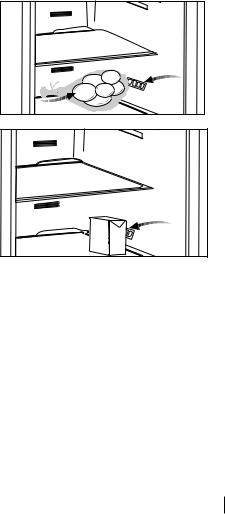
Recommendations for freshfood compartment
* OPTIONAL
•Please do not let any foodstuff to come to contact with the temperature sensor in freshfood compartment.
In order to maintain freshfood compartment at ideal storage temperature, the sensor must not be blocked by fodstuffs.
•Do not place hot foodstuff in your appliance.
food |
temperature |
sensor |
MILK |
temperature |
juice |
|
etc. |
sensor |
|
8 EN
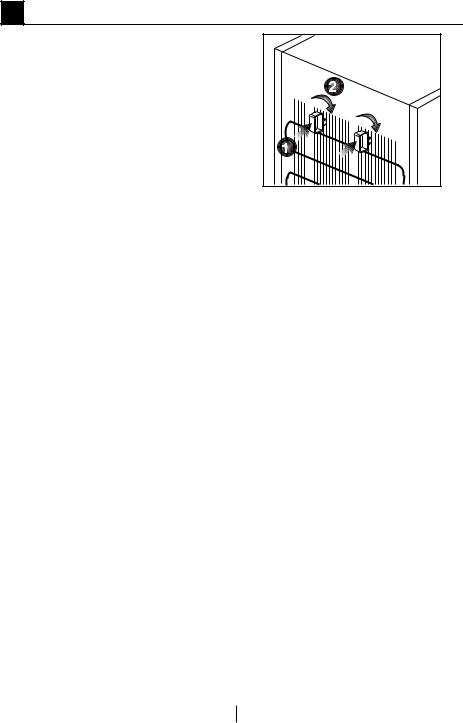
3 Installation
B Please remember that the manufacturer shall not be held liable if the information given in the
instruction manual is not observed.
Points to be considered when re-transporting your refrigerator
1.Your refrigerator must be emptied and cleaned prior to any transportation.
2.Shelves, accessories, crisper and etc. in your refrigerator must be fastened securely by adhesive tape against any jolt before repackaging.
3.Packaging must be tied with thick tapes and strong ropes and the rules of transportation printed on the package must be followed.
Please do not forget…
Every recycled material is an indispensable source for the nature and for our national resources.
If you wish to contribute to recycling the packaging materials, you can get further information from the environmental bodies or local authorities.
Before operating your refrigerator
Before starting to use your refrigerator check the following:
1.Is the interior of the refrigerator dry and can the air circulate freely in the rear of it?
2.Please install the 2 plastic wedges as illustrated in the figure. Plastic wedges will provide the required distance between your refrigerator and the wall in order to allow the air circulation. (The illustrated figure is only an example and does not match exactly with your product.)
3.Clean the interior of the refrigerator as recommended in the “Maintenance and cleaning” section.
4.Plug the refrigerator into the wall outlet. When the fridge door is open, the fridge compartment interior light will come on.
5.You will hear a noise as the compressor starts up. The liquid and gases sealed within the refrigeration system may also give rise to noise, even if the compressor is not running and this is quite normal.
6.Front edges of the refrigerator may feel warm. This is normal. These areas are designed to be warm to
avoid condensation.
Electric connection
Connect your product to a grounded socket which is being protected by a fuse with the appropriate capacity.
Important:
9 EN

•The connection must be in compliance with national regulations.
•The power cable plug must be easily accessible after installation.
•The specified voltage must be equal to your mains voltage.
•Extension cables and multiway plugs must not be used for connection.
B A damaged power cable must be replaced by a qualified electrician.
B Product must not be operated before it is repaired! There is danger of
electric shock!
Disposing of the packaging
The packing materials may be dangerous for children. Keep the packing materials out of the reach of children or dispose of them by
classifying them in accordance with the waste instructions. Do not dispose of them along with the normal household waste.
The packing of your refrigerator is produced from recyclable materials.
Disposing of your old refrigerator
Dispose of your old refrigerator without giving any harm to the environment.
•You may consult your authorised dealer or waste collection center of your municipality about the disposal of your refrigerator.
Before disposing of your refrigerator, cut out the electric plug and, if there are any locks on the door, make them inoperable in order to protect children against any danger.
Placing and Installation
A If the entrance door of the room where the refrigerator will be installed is not wide enough for the refrigerator to pass through, then call the authorised service to have them remove the doors of your refrigerator and pass it sideways through the door.
1.Install your refrigerator to a place that allows ease of use.
2.Keep your refrigerator away from heat sources, humid places and direct sunlight.
3.There must be appropriate air ventilation around your refrigerator in order to achieve an efficient operation. If the refrigerator is to be placed in a recess in the wall, there must be at least 5 cm distance with the ceiling and at least 5 cm with the wall. If the floor is covered with a carpet, your product must be elevated 2.5 cm from the floor.
4.Place your refrigerator on an even floor surface to prevent jolts.
10 EN
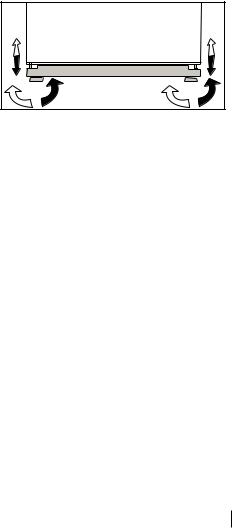
Adjusting the feet
If your refrigerator is unbalanced;
You can balance your refrigerator by turning the front legs as shown in the illustration below. The corner where the leg exists is lowered when you turn it in the direction of black arrow and raised when you turn in the opposite direction. Taking help from someone to slightly lift the refrigerator will facilitate this process.
Open door warning
An audio warning will be given when the fridge or freezer compartment door of your product is left open for a certain period of time. This audio warning signal will mute when any button on the indicator is pressed or when the door is closed.
* OPTIONAL
Changing the illumination lamp
To change the lamp used for illumination of your refrigerator, please call your Authorized Service.
11 EN
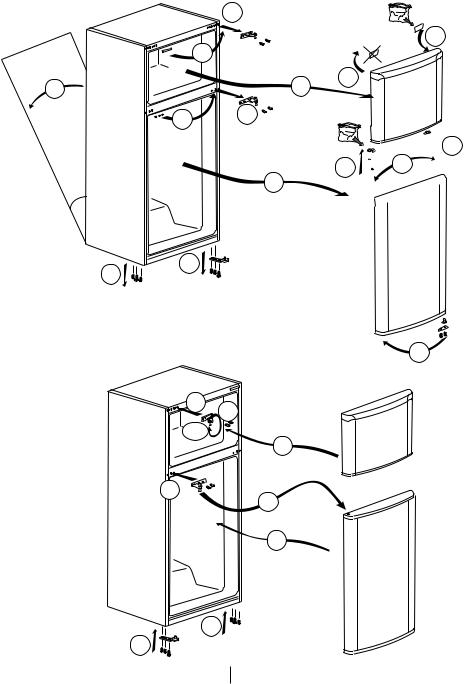
Reversing the doors
Proceed in numerical order
|
4 |
|
11 |
|
5 |
7 |
2 |
6 |
1 |
 12
12
 14
14  3
3 

60¡
8 |
9 |
|
15
|
19 |
18 |
|
180¡ |
|
|
21 |
|
|
|
|
22 |
|
20 |
|
|
|
|
|
21 |
17
16
12 EN

4 |
Preparation |
|
|
C |
Your refrigerator should be installed at |
CThis appliance is designed to operate |
|
least 30 cm away from heat sources |
at temperatures specified in the table |
||
such as hobs, ovens, central heater |
|||
below is equipped with Advanced |
|||
and stoves and at least 5 cm away |
|||
Electronic Temperature Control |
|||
from electrical ovens and should not |
|||
System [AETCS] which ensures |
|||
be located under direct sunlight. |
|||
that at the advised setting [4 - four |
|||
C Please make sure that the interior |
|||
on the knob] the frozen food in the |
|||
of your refrigerator is cleaned |
|||
freezer will not defrost even if the |
|||
thoroughly. |
|||
ambient temperature falls as low |
|||
C If two refrigerators are to be installed |
|||
as -15 °C. When first installed the |
|||
side by side, there should be at least |
product MUST NOT be placed in low |
||
2 cm distance between them. |
ambient temperatures because the |
||
C When you operate your refrigerator |
freezer will not reduce to it’s standard |
||
for the first time, please observe the |
operating temperature. Once it has |
||
following instructions during the initial |
reached its steady operating state it |
||
six hours. |
can be re-located. So you may then |
||
- The door should not be opened |
install your appliance in a garage or |
||
|
frequently. |
an unheated room without having to |
|
- It must be operated empty without |
worry about frozen food in the freezer |
||
|
any food in it. |
being spoilt. However at low ambient |
|
- Do not unplug your refrigerator. If |
temperatures mentioned above, |
||
|
a power failure occurs out of your |
fridge contents are likely to freeze, |
|
|
control, please see the warnings in |
so check and consume food in the |
|
|
the “Recommended solutions for |
fridge accordingly. When the ambient |
|
|
the problems” section. |
temperature returns to normal, you |
|
C Original packaging and foam |
may change the knob setting to suit |
||
materials should be kept for future |
your needs. |
||
CIf the ambient temperature is |
|||
transportations or moving. |
|||
|
|
below 0°C, the food in the fridge |
|
|
|
compartment will freeze.So, we |
|
|
|
recommend you don’t use the fridge |
|
|
|
compartment in such low ambient |
|
|
|
conditions. You can continue using |
|
|
|
the freezer compartment as usual. |
|
13 EN
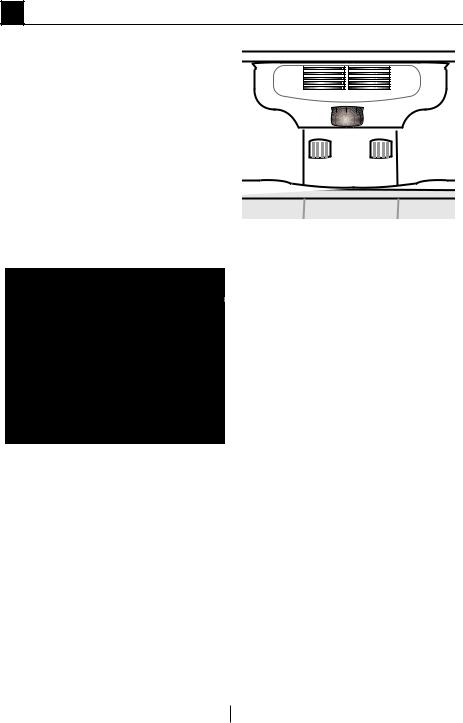
5 Using your refrigerator
Fridge compartment thermostat setting button
Thermostat button allows you to make the general temperature setting of your refrigerator.
Thermostat button of the refrigerator controls both the temperature
of the freezer compartment and the amount of the air send to the fridge compartment and thus, the temperature of the fridge compartment.
At regular room temperatures:
Set the thermostat button to a position between “2 and 3” to store your food.
At high room temperatures:
5 |
4 |
3 |
Thermostat button must be set to a cooler position if the food is going to be frozen or large amounts of food will be loaded.
If the food in the fridge compartment
cools too much or freezes, thermostat button must be set to position “1”.
If the fridge compartment is colder then the required 24 hours after the initial startup, open the lower door and turn the fridge compartment temperature setting button towards to the position “1” and if it is warmer then the required, slightly turn it towards to the position “5”.
14 EN
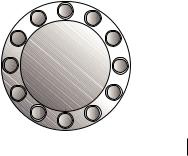
Freezer compartment thermostat setting button
Freezer compartment setting button can be set to a position between Normal and Quick Freezing.
•In Normal position, the amount of the air sent to the fridge compartment reaches to maximum.
•In Quick Freezing position, the amount of the air sent to the freezer compartment reaches to maximum. And the amount of the air sent to the fridge compartment decreases to minimum. In this case, the temperature of the fridge compartment will increase. This is normal.
•If you do not need more cooling in either of the compartments, leave the setting button in Normal position.
•In cases where the room temperature is high (25 °C and above), it is suggested to set the freezer compartment setting button to a position near the Normal.
•In low room temperatures, it is suggested to set the freezer
compartment setting button to a position between the Normal and Quick Freezing.
Making ice
Fill the ice container with water and place it into its seat. Your ice will be ready approximately in two hours.
You can easily remove your ice by slightly twisting the ice container.
15 EN

Freezer |
Fridge |
Explanations |
Compartment |
Compartment |
|
Adjustment |
Adjustment |
|
|
|
|
-18°C |
4°C |
This is the normal recommended setting. |
-20,-22 or -24°C |
4°C |
These settings are recommended when |
|
|
the ambient temperature exceeds 30°C. |
Quick Freeze |
4°C |
Use when you wish to freeze your food in a |
|
|
short time. Your refrigerator will return to its |
|
|
previous mode when the process is over. |
-18°C or colder |
2°C |
If you think that your fridge compartment |
|
|
is not cold enough because of the hot |
|
|
conditions or frequent opening and closing |
|
|
of the door. |
-18°C or colder |
Quick Fridge |
You can use it when your fridge |
|
|
compartment is overloaded or if you |
|
|
wish to cool down your food rapidly. It |
|
|
is recommended that you activate quick |
|
|
fridge function 4-8 hours before placing |
|
|
the food. |
Freezing fresh food
•It must be preferred to wrap or cover the food before placing them in the refrigerator.
•Hot food must cool down to the room temperature before putting them in the refrigerator.
•The foodstuff that you want to freeze must be fresh and in good quality.
•Foodstuff must be divided into portions according to the family’s daily or meal based consumption needs.
•The foodstuff must be packaged in an airtight manner to prevent them from drying even if they are going to be kept for a short time.
•Materials to be used for packaging must be tear-proof and resistant to cold, humidity, odor, oils and acids and they must also be airtight.
Moreover, they must be well closed and they must be made from easy- to-use materials that are suitable for deep freeze usage.
•Frozen food must be used immediately after they are thawed and they should never be re-frozen.
•Please observe the following instructions to obtain the best results.
1.Do not freeze too large quantities of food at one time. The quality of the food is best preserved when it is frozen right through to the core as quickly as possible.
2.Placing warm food into the freezer compartment causes the cooling system to operate continuously until the food is frozen solid.
3.Take special care not to mix already frozen food and fresh food.
Recommendations for preservation of frozen food
•Prepacked commercially frozen
16 EN food should be stored in accordance

with the frozen food manufacturer's instructions for a  ( 4 star) frozen food storage compartment.
( 4 star) frozen food storage compartment.
• To ensure that the high quality achieved by the frozen food manufacturer and the food retailer is maintained, the following should be remembered:
1.Put packages in the freezer as quickly as possible after purchase.
2.Ensure that contents are labeled and dated.
3.Do not exceed "Use By", "Best Before" dates on the packaging.
Defrosting
The freezer compartment defrosts automatically.
Placing the food
|
Various frozen |
|
Freezer |
food such as |
|
compartment |
meat, fish, ice |
|
shelves |
cream, vegetables |
|
|
and etc. |
|
Egg tray |
Egg |
|
|
|
|
Fridge |
Food in pans, |
|
covered plates |
||
compartment |
||
and closed |
||
shelves |
||
containers |
||
|
||
|
|
|
|
Small and |
|
Fridge |
packaged food |
|
compartment |
or drinks (such as |
|
door shelves |
milk, fruit juice and |
|
|
beer) |
|
Crisper |
Vegetables and |
|
fruits |
||
|
||
|
|
|
Freshzone |
Delicatessen |
|
products (cheese, |
||
compartment |
||
butter, salami and |
||
|
||
|
etc.) |
Deep-freeze information
Food must be frozen as rapidly as possible when they are put in a refrigerator in order to keep them in good quality.
The TSE norm requires (according to certain measurement conditions) the refrigerator to freeze at least 4.5 kg of foodstuff at 32°C ambient temperature to -18°C or lower within 24 hours for every 100-liters of freezer volume.
It is possible to keep the food for a long time only at -18°C or lower temperatures.
You can keep the freshness of food for many months (at -18°C or lower temperatures in the deep freeze).
WARNING! A
•Foodstuff must be divided into portions according to the family’s daily or meal based consumption needs.
•Foodstuff must be packaged in an airtight manner to prevent them from drying even if they are going to be kept for a short time.
Materials necessary for packaging:
•Cold resistant adhesive tape
•Self adhesive label
•Rubber rings
•Pen
Materials to be used for packaging the foodstuff must be tear-proof and resistant to cold, humidity, odor, oils and acids.
Foodstuff to be frozen should not be allowed to come in contact with the previously frozen items to prevent their partial thawing.
Frozen food must be used immediately after they are thawed and they should never be re-frozen.
17 EN

6 Maintenance and cleaning
A Never use gasoline, benzene or similar substances for cleaning purposes.
B We recommend that you unplug the appliance before cleaning.
B Never use any sharp abrasive instrument, soap, household cleaner, detergent and wax polish for cleaning.
CUse lukewarm water to clean the cabinet of your refrigerator and wipe it dry.
CUse a damp cloth wrung out in a solution of one teaspoon of
bicarbonate of soda to one pint of water to clean the interior and wipe it dry.
B Make sure that no water enters the lamp housing and other electrical items.
B If your refrigerator is not going to be used for a long period of time, unplug the power cable, remove all food, clean it and leave the door ajar.
CCheck door seals regularly to ensure they are clean and free from food particles.
A To remove door racks, remove all the contents and then simply push the door rack upwards from the base.
ANever use cleaning agents or water that contain chlorine to clean the outer surfaces and chromium coated parts of the product. Chlorine causes
corrosion on such metal surfaces.
Protection of plastic surfaces
CDo not put the liquid oils or oil-cooked meals in your refrigerator in unsealed containers as they damage the plastic surfaces of your refrigerator. In case of spilling or smearing oil on the plastic surfaces, clean and rinse the relevant part of the surface at once with warm water.
18 EN
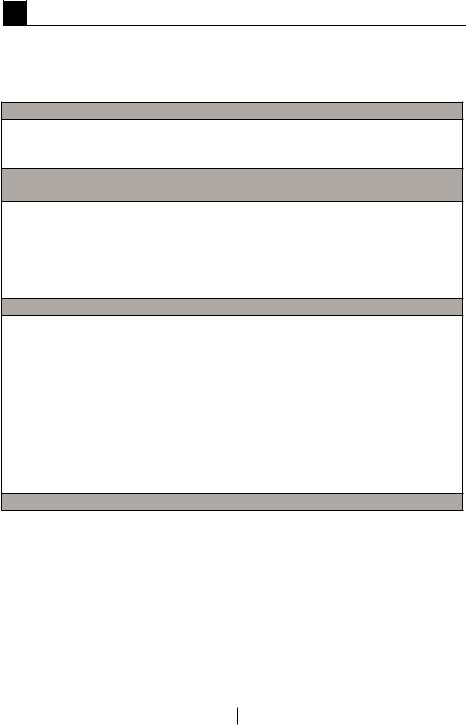
7 Recommended solutions for the problems
Please review this list before calling the service. It might save you time and money. This list includes frequent complaints that are not arising from defective workmanship or material usage. Some of the features described here may not exist in your product.
The refrigerator does not operate.
•Is the refrigerator properly plugged in? Insert the plug to the wall socket.
•Is the fuse of the socket which your refrigerator is connected to or the main fuse blown out? Check the fuse.
Condensation on the side wall of the fridge compartment (MULTIZONE, COOL CONTROL and FLEXI ZONE).
•Very cold ambient conditions. Frequent opening and closing of the door. Highly humid ambient conditions. Storage of food containing liquid in open containers. Leaving the door ajar. Switching the thermostat to a colder degree.
•Decreasing the time the door left open or using it less frequently.
•Covering the food stored in open containers with a suitable material.
•Wipe the condensation using a dry cloth and check if it persists.
Compressor is not running
•Protective thermic of the compressor will blow out during sudden power failures or plug-out plug-ins as the refrigerant pressure in the cooling system of the refrigerator has not been balanced yet. Your refrigerator will start running approximately after 6 minutes. Please call the service if the refrigerator does not startup at the end of this period.
•The fridge is in defrost cycle. This is normal for a full-automatically defrosting refrigerator. Defrosting cycle occurs periodically.
•Your refrigerator is not plugged into the socket. Make sure that the plug is properly fit into the socket.
•Are the temperature adjustments correctly made?
•Power might be cut off.
The fridge is running frequently or for a long time.
19 EN
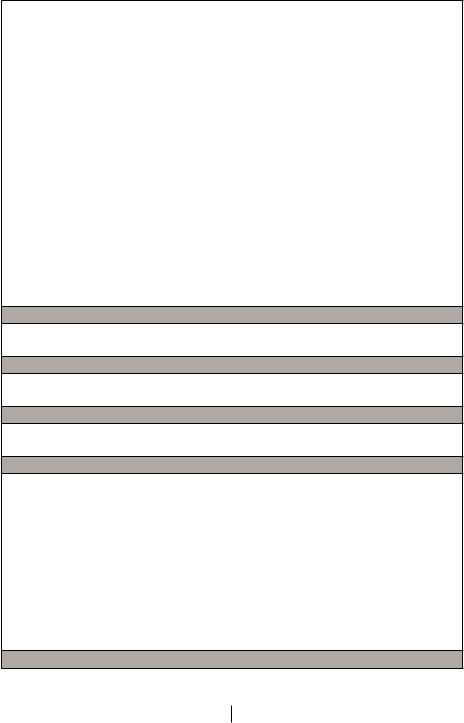
•Your new product may be wider than the previous one. This is quite normal.
Large refrigerators operate for a longer period of time.
•The ambient room temperature may be high. This is quite normal.
•The refrigerator might have been plugged in recently or might have been loaded with food. Cooling down of the refrigerator completely may last for a couple of hours longer.
•Large amounts of hot food might have been put in the refrigerator recently. Hot food causes longer running of the refrigerator until they reach the safe storage temperature.
•Doors might have been opened frequently or left ajar for a long time. The warm air that has entered into the refrigerator causes the refrigerator to run for longer periods. Open the doors less frequently.
•Freezer or fridge compartment door might have been left ajar. Check if the doors are tightly closed.
•The refrigerator is adjusted to a very low temperature. Adjust the refrigerator temperature to a warmer degree and wait until the temperature is achieved.
•Door seal of the fridge or freezer may be soiled, worn out, broken or not properly seated. Clean or replace the seal. Damaged/broken seal causes the refrigerator to run for a longer period of time in order to maintain the current temperature.
Freezer temperature is very low while the fridge temperature is sufficient.
•The freezer temperature is adjusted to a very low temperature. Adjust the freezer temperature to a warmer degree and check.
Fridge temperature is very low while the freezer temperature is sufficient.
•The fridge temperature might have been adjusted to a very low temperature.
Adjust the fridge temperature to a warmer degree and check.
Food kept in the fridge compartment drawers are freezing.
•The fridge temperature might have been adjusted to a very low temperature.
Adjust the fridge temperature to a warmer degree and check.
Temperature in the fridge or freezer is very high.
•The fridge temperature might have been adjusted to a very high degree.
Fridge adjustment has an effect on the temperature of the freezer. Change the temperature of the fridge or freezer until the fridge or freezer temperature reaches to a sufficient level.
•Doors might have been opened frequently or left ajar for a long time; open them less frequently.
•Door might have been left ajar; close the door completely.
•Large amount of hot food might have been put in the refrigerator recently. Wait until the fridge or freezer reaches the desired temperature.
•The refrigerator might have been plugged in recently. Cooling down of the refrigerator completely takes time.
The operation noise increases when the refrigerator is running.
20 EN
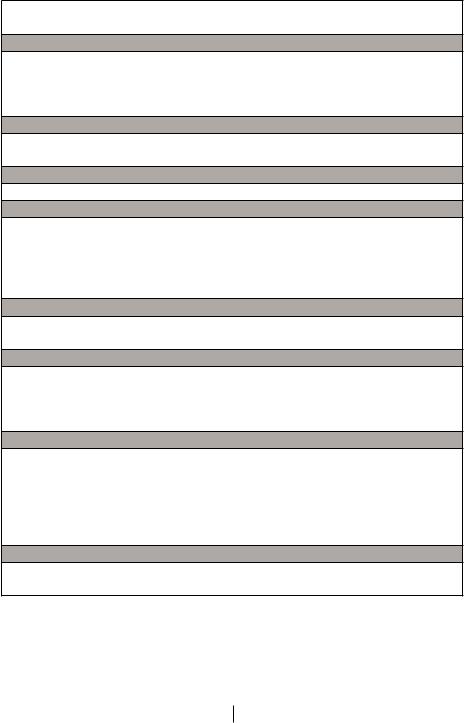
•The operating performance of the refrigerator may change due to the changes in the ambient temperature. It is normal and not a fault.
Vibrations or noise.
•The floor is not even or it is weak. The refrigerator rocks when moved slowly.
Make sure that the floor is strong enough to carry the refrigerator, and level.
•The noise may be caused by the items put onto the refrigerator. Items on top of the refrigerator should be removed.
There are noises coming from the refrigerator like liquid spilling or spraying.
•Liquid and gas flows happen in accordance with the operating principles of your refrigerator. It is normal and not a fault.
There is a noise like wind blowing.
•Fans are used in order to cool the refrigerator. It is normal and not a fault.
Condensation on the inner walls of refrigerator.
•Hot and humid weather increases icing and condensation. It is normal and not a fault.
•Doors might have been left ajar; make sure that the doors are closed fully.
•Doors might have been opened frequently or left ajar for a long time; open them less frequently.
Humidity occurs on the outside of the refrigerator or between the doors.
•There might be humidity in the air; this is quite normal in humid weather. When the humidity is less, condensation will disappear.
Bad odour inside the refrigerator.
•Inside of the refrigerator must be cleaned. Clean the inside of the refrigerator with a sponge, lukewarm water or carbonated water.
•Some containers or package materials might cause the smell. Use a different container or different brand packaging material.
The door is not closing.
•Food packages may prevent the door's closing. Replace the packages that are obstructing the door.
•The refrigerator is not completely upright on the floor and rocking when slightly moved. Adjust the elevation screws.
•The floor is not level or strong. Make sure that the floor is level and capable to carry the refrigerator.
Crispers are stuck.
•The food might be touching the ceiling of the drawer. Rearrange food in the drawer.
21 EN
Pirmiausia įdėmiai perskaitykite šį vadovą!
Gerbiamas pirkėjau,
Mes tikimės, kad mūsų gaminys, kuris buvo sukurtas moderniose gamyklose ir kruopščiai patikrintas pagal griežtus kokybės kontrolės reikalavimus, veiksmingai ir ilgai jums tarnaus.
Todėl mes rekomenduojame jums prieš naudojimą atidžiai perskaityti visą šio gaminio vartotojo vadovą ir išsaugoti jį, kad galėtumėte pasinaudoti juo ateityje.
Šis vadovas
•Padės jums greitai ir saugiai naudoti šį buitinį prietaisą.
•Prieš sumontuodami ir pradėdami naudoti šį gaminį, perskaitykite šį vadovą.
•Vadovaukitės nurodymais, ypač nurodymais dėl saugos.
•Laikykite šį vadovą lengvai pasiekiamoje vietoje, nes juo dar gali tekti pasinaudoti.
•Taip pat perskaitykite ir kitus su šiuo gaminiu pateiktus dokumentus.
Atkreipkite dėmesį, kad šis vadovas gali galioti ir kitiems modeliams.
Ženklai ir jų aprašymas
Šioje naudojimo instrukcijoje panaudoti tokie ženklai:
C Svarbi informacija arba naudingi patarimai dėl naudojimo.
AĮspėjimas dėl sveikatai pavojingų arba žalos turtui galinčių padaryti sąlygų.
BĮspėjimas dėl elektros įtampos.

TURINYS
1 Šaldytuvas |
3 |
2 Svarbūs įspėjimai dėl |
|
saugos |
4 |
Naudojimo paskirtis............................ |
4 |
Bendrieji saugos reikalavimai.............. |
4 |
Gaminiams su vandens dalytuvu;....... |
6 |
Vaikų sauga........................................ |
6 |
WEEE Direktyvos ir senų gaminių |
|
išmetimo taisyklių atitiktis: .................. |
6 |
RoHS direktyvos atitiktis:.................... |
6 |
Informacija apie pakuotę.................... |
6 |
HCA įspėjimas.................................... |
6 |
Jeigu gaminyje įrengta aušinimo |
|
sistema, kurioje naudojama R600a: ... 6 |
|
Nepaisykite šio įspėjimo, jeigu gaminyje |
|
įrengta aušinimo sistema, kurioje |
|
naudojama R134a. ............................ |
6 |
Ką reikia daryti, norint sutaupyti |
|
energijos............................................ |
6 |
Patarimai dėp šviežio maisto skyriaus |
|
naudojimo.......................................... |
7 |
3 Įrengimas |
8 |
Į ką reikia atsižvelgti vežant šį |
|
šaldytuvą............................................ |
8 |
Prieš pradedant naudoti šaldytuvą...... |
8 |
Elektros prijungimas........................... |
8 |
Pakuotės išmetimas........................... |
9 |
Seno šaldytuvo išmetimas.................. |
9 |
Pastatymas ir instaliacija..................... |
9 |
Kojelių reguliavimas............................ |
9 |
Apšvietimo lemputės pakeitimas ....... |
9 |
Durų perstatymas............................. |
10 |
4 Paruošimas |
11 |
5 Šaldytuvo |
|
eksploatavimas |
12 |
Šaldytuvo skyriaus termostato |
|
nustatymo rankenėlė ....................... |
12 |
Šviežių maisto produktų užšaldymas.13 |
|
Šaldiklio skyriaus termostato |
|
nustatymo rankenėlė ....................... |
13 |
Ledukų gamyba............................... |
13 |
Užšaldytų maisto produktų saugojimo |
|
rekomendacijos................................ |
14 |
Informacija apie gilų užšaldymą........ |
14 |
Kokius maisto produktus galima dėti.15 |
|
6 Techninė priežiūra ir |
|
valymas |
16 |
Plastikinių paviršių apsauga ............. |
16 |
7 Rekomenduojami problemų sprendimo būdai17
2 LT
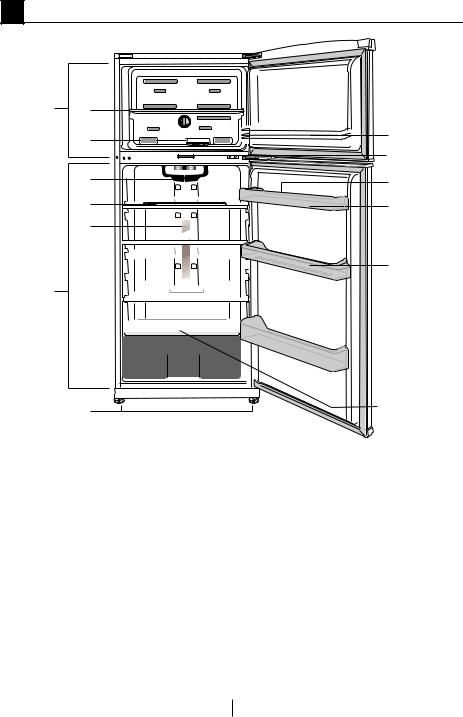
1 Šaldytuvas
13 1
*2
3 


*4
*9
*12
10
*11
5  4
4 

11
144 
6 


*7

 11
11
8 |
*12 |
|
1. |
Šaldiklio skyriaus lentynos |
8. |
Reguliuojamos kojelės |
|
2. |
Ledo konteineris |
|||
9. |
Šaldiklio skyriaus durų lentyna |
|||
3. |
Šaldytuvo skyriaus termostato nustatymo |
|||
10. |
Kiaušinių dėklas |
|||
|
rankenėlė |
|||
|
11. |
Šaldytuvo skyriaus durų lentyna |
||
4. |
Pritaikomos korpuso lentynos |
|||
12. |
Raktas |
|||
5. |
Apšvietimo lemputės |
|||
13. |
Šaldiklio skyrius |
|||
6. |
Stalčiaus daržovėms dangtis |
|||
14. |
Šaldytuvo skyrius |
|||
7. |
Daržovių dėtuvė |
|||
|
|
* PAPILDU PIEDERUMS
Šiame eksploatavimo vadove pateikti paveikslėliai yra orientacinio pobūdžio; gali būti, kad jie tiksliai nevaizduoja jūsų turimo gaminio. Jei jūsų turimame gaminyje nėra aprašomų dalių, tai reiškia, jog tai taikoma kitiems modeliams.
3 LT

2 Svarbūs įspėjimai dėl saugos
Prašome atidžiai perskaityti toliau pateiktą informaciją. Nepaisant šios informacijos, galima susižaloti arba padaryti žalos turtui. Tuomet nebegalios jokia garantija ir gamintojo įsipareigojimai.
Jūsų įsigytas prietaisas numatytas naudoti 10 metų. Šiuo laikotarpiu gamintojas įsipareigoja tiekti visas šiam prietaisui reikalingas atsargines dalis, kad prietaisas veiktų taip, kaip aprašyta šioje instrukcijoje.
Naudojimo paskirtis
Šis gaminys skirtas naudoti
–patalpose ir uždarose vietose, pavyzdžiui, namuose;
–uždaroje darbo aplinkoje, pavyzdžiui, parduotuvėse ir biuruose;
–uždarose apgyvendinimo vietose, pavyzdžiui, ūkininkų gyvenamuosiuose namuose, viešbučiuose, pensionuose.
• Šio gaminio negalima naudoti lauke.
Bendrieji saugos reikalavimai
•Kai šį gaminį norėsite išmesti arba atiduoti į metalo laužą, rekomenduojama pasikonsultuoti su įgaliotomis tarnybomis ir institucijomis, kad sužinotumėte reikiamą informaciją.
•Jei kyla klausimų apie šaldytuvą arba atsiranda problemų, pasikonsultuokite su įgaliotais aptarnavimo specialistais.
Šaldytuvo neardykite ir niekam neleiskite to daryti; tai galima daryti tik apie tai pranešus įgaliotiems aptarnavimo specialistams.
•Gaminiams su šaldiklio kamera; Ledų ir ledo kubelių nevalgykite vos juos išėmę į šaldiklio kameros! (Galite nušalti burną.)
•Gaminiams su šaldiklio kamera; Į šaldiklio kamerą nedėkite butelių ir skardinių su gėrimais. jie gali sprogti.
•Užšaldytų maisto produktų nelieskite rankomis – jie gali prilipti prie rankų.
•Prieš valydami arba atšildydami šaldytuvą, atjunkite jį nuo elektros tinklo.
•Šaldytuvui valyti ir šerkšnui šalinti negalima naudoti garų ir garinių valomųjų medžiagų. Garai gali pasiekti elektrines dalis ir sukelti trumpą jungimą arba elektros smūgį.
•Šaldytuvo dalių, pavyzdžiui, nuo spyrio apsaugančios plokštės arba durelių, nenaudokite kaip atramos ar laiptelio.
•Šaldytuvo viduje nenaudokite elektros prietaisų.
•Žiūrėkite, kad gręžimo ar pjovimo įrankiais nepažeistumėte dalių, kuriose cirkuliuoja aušinamasis skystis. Iš pradurtų garintuvo dujų kanalų, vamzdžių ilgintuvų arba paviršiaus dangų ištryškęs aušinamasis skystis gali suerzinti odą ir pažeisti akis.
•Jokiomis medžiagomis neuždenkite ir neužkimškite šaldytuvo ventiliacinių angų.
•Elektrinius prietaisus privalo taisyti tik
įgaliotieji asmenys. Jei remontą vykdys nekompetentingi asmenys, naudotojui gali kilti pavojus.
•Įvykus trikčiai, taip pat techninės priežiūros arba remonto metu šaldytuvui atjunkite elektros maitinimą – arba išsukite atitinkamą saugiklį, arba ištraukite prietaiso laido kištuką.
•Netraukite laikydami už laido – traukite laikydami už kištuko.
•Stiprius alkoholinius gėrimus stipriai užkimškite ir laikykite vertikalioje padėtyje.
•Šaldytuve niekada nelaikykite flakonų su degiomis ir sprogiomis medžiagomis.
•Norėdami paspartinti atitirpinimo procesą, nenaudokite jokių mechaninių prietaisų ar kitų priemonių, išskyrus gamintojo rekomenduojamas.
•Šis buitinis prietaisas nėra skirtas naudoti asmenims (įskaitant vaikus) su fiziniais, jutimo ar protiniais sutrikimais arba asmenims, kurie turi nepakankamai patirties ir žinių naudoti šį prietaisą, nebent juos tinkamai prižiūrėtų (arba nurodytų, kaip naudoti šį buitinį prietaisą) už jų saugą atsakingas asmuo.
4 LT
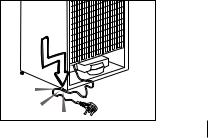
•Nenaudokite sugedusio šaldytuvo. Jeigu dėl ko nors nerimaujate, pasikonsultuokite su techninio aptarnavimo specialistais.
•Šaldytuvo elektros sauga garantuojama tik tuo atveju, jei jūsų name įrengta įžeminimo sistema atitinka standartus.
•Gaminį statyti vietoje, neapsaugotoje nuo lietaus, sniego, saulės ir vėjo, pavojinga elektros saugos požiūriu.
•Jeigu maitinimo kabelis būtų pažeistas, susisiekite su įgaliotuoju techninio aptarnavimo centru, kad išvengtumėte pavojaus.
•įrengimo metu draudžiama šaldytuvo maitinimo laido kištuką įkišti į sieninį lizdą – galite žūti arba patirti rimtą traumą.
•Šis šaldytuvas skirtas tik maisto produktams laikyti. Prietaiso negalima naudoti kitai paskirčiai.
•Etiketė, kurioje nurodomi techniniai gaminio duomenys, pritvirtinta vidinėje kairėje šaldytuvo pusėje.
•Niekada nejunkite šio šaldytuvo į elektros energijos taupymo sistemas; jos gali sugadinti šaldytuvą.
•Jeigu šaldytuve įrengta mėlyna kontrolinė lemputė, nežiūrėkite į mėlyną šviesą pro optinius prietaisus.
•Jeigu naudojate rankiniu būdu valdomą
šaldytuvą, nutrūkus elektros tiekimui, prieš vėl jį įjungdami, palaukite bent 5 minutes.
•Atidavus šį gaminį kitiems, naujam gaminio savininkui reikia atiduoti ir šią naudojimo instrukciją.
•Gabendami šaldytuvą, stenkitės nepažeisti maitinimo kabelio. Sulenktas kabelis gali sukelti gaisrą. Ant maitinimo kabelio niekada nestatykite sunkių daiktų. Jungdami gaminį į maitinimo tinklą, nelieskite kištuko drėgnomis rankomis.
•Nejunkite šaldytuvo, jeigu sieninis lizdas yra atsilaisvinęs.
•Saugumo sumetimais nepukškite vandens tiesiai ant vidinių arba išorinių šio gaminio dalių.
•Nepurkškite šalia šaldytuvo degių medžiagų, pavyzdžiui, propano dujų ir pan., nes kyla gaisro ir sprogimo pavojus.
•Nestatykite ant šaldytuvo indų su vandeniu, nes gali kilti elektros smūgis arba gaisras.
•Neprikraukite į šaldytuvą per daug maisto produktų. Pridėjus per daug maisto produktų, atidarant arba uždarant šaldytuvo duris, jie gali iškristi ir sužeisti. Niekada nestatykite ant šaldytuvo daiktų, nes atidarius arba uždarius šaldytuvo dureles, jie gali nukristi.
•Šaldytuve negalima laikyti medžiagų, kurioms saugoti reikia tikslios temperatūros, pavyzdžiui, vakcinų, temperatūrai jautrių vaistų, mokslinių tyrimų medžiagų ir pan.
•Jeigu šaldytuvo ilgai nenaudojate, būtinai atjunkite jį nuo maitinimo tinklo. Dėl galimo maitinimo kabelio pažeidimo gali kilti gaisras.
•Elektros kištuką reikia reguliariai nuvalyti, kitaip jis gali sukelti gaisrą.
•Elektros kištuką reikia reguliariai valyti sausu skudurėliu, kitaip gali kilti gaisras.
•Jeigu reguliuojamos kojelės netvirtai remsis į grindis, šaldytuvas gali judėti.
Pareguliuokite reguliuojamas kojeles, kad jos tinkamai remtųsi į grindis ir šaldytuvas nejudėtų.
•Nešdami šaldytuvą, nelaikykite jo už durų rankenos. Kitaip ji gali nulūžti.
•Jeigu šį gaminį reikia statyti prie kito
šaldytuvo arba šaldiklio, tarp prietaisų būtina palikti bent 8 cm tarpą. Kitaip gretimos šoninės sienelės gali pradėti rasoti.
5 LT

Gaminiams su vandens dalytuvu;
Slėgis vandentiekio vamzdyje turi būti ne mažesnis nei 1 baras. Slėgis vandentiekio vamzdyje turi būti ne didesnis nei 8 barai.
•Naudokite tik geriamąjį vandenį.
Vaikų sauga
•Jeigu durelės rakinamos spyna, laikykite raktą vaikams nepasiekiamoje vietoje.
•Privaloma prižiūrėti mažus vaikus, kad jie nežaistų su šiuo buitiniu prietaisu.
WEEE Direktyvos ir senų gaminių išmetimo taisyklių atitiktis:
Šis gaminys atitinka ES WEEE Direktyvą (2012/19/ES). Šis gaminys paženklintas elektros
ir elektroninės įrangos klasifikavimo (WEEE) ženklu.
Šis gaminys pagamintas iš aukštos kokybės medžiagų ir
dalių, kurias galima perdirbti ir pakartotinai panaudoti. Pasibaigus gaminio tarnavimo laikui, neišmeskite jo kartu su įprastomis buitinėmis atliekomis. Atiduokite jį
į surinkimo punktą, kad elektros ir elektronikos įranga būtų perdirbta. Surinkimo punktų adresus sužinosite vietos savivaldybėje.
RoHS direktyvos atitiktis:
Jūsų įsigytas gaminys atitinka ES RoHS Direktyvą (2011/65/ES). Jame nėra šioje Direktyvoje nurodytų kenksmingų ir draudžiamų medžiagų.
Informacija apie pakuotę
Šio gaminio pakavimo medžiagos pagamintos iš pakartotinai panaudojamų medžiagų, atsižvelgiant į mūsų nacionalinius aplinkosaugos reglamentus. Neišmeskite pakavimo medžiagų kartu su kitomis buitinėmis atliekomis arba kitomis šiukšlėmis. Išmeskite pakavimo medžiagas į tam skirtą vietos atliekų surinkimo punktą.
HCA įspėjimas
Jeigu gaminyje įrengta aušinimo sistema, kurioje naudojama R600a:
Šios dujos lengvai užsiliepsnoja. Todėl būkite atsargūs, kad eksploatavimo ir transportavimo metu nepažeistumėte aušinimo sistemos ir vamzdžių. Pažeidimo atveju, saugokite gaminį nuo galimų liepsnos šaltinių, nuo kurių gaminys galėtų užsidegti, ir vėdinkite patalpą, kurioje stovi šis prietaisas.
Nepaisykite šio įspėjimo, jeigu gaminyje įrengta aušinimo sistema, kurioje naudojama R134a.
Gaminyje naudojamų dujų rūšis nurodyta techninių gaminio duomenų etiketėje, kuri yra pritvirtinta vidinėje kairėje šaldytuvo pusėje.
Niekuomet nedeginkite šio buitinio prietaiso.
Ką reikia daryti, norint sutaupyti energijos
•Nelaikykite šaldytuvo durelių atidarytų ilgą laiką.
•Į šaldytuvą nedėkite karšo maisto arba gėrimų.
•Į šaldytuvą nedėkite pernelyg daug maisto produktų, kad nebūtų kliudoma viduje cirkuliuoti orui.
•Šaldytuvo nestatykite vietoje, kur šviečia tiesioginiai saulės spinduliai arba arti šilumą skleidžiančių prietaisų, pavyzdžiui, orkaičių, indaplovių arba radiatorių.
6 LT

•Maisto produktus laikykite uždaruose
induose. |
|
|
|
• Gaminiuose su šaldymo kamera; išėmę |
|
|
|
šaldiklio lentyną arba stalčių, šaldiklio |
|
|
|
kameroje galite laikyti maksimalų produktų |
|
|
|
kiekį. Paskelbtosios šaldytuvo energijos |
|
|
|
sąnaudos nustatytos išėmus šaldiklio |
food |
temperature |
|
kameros lentyną arba ištraukus stalčių |
sensor |
||
|
|
||
ir sudėjus maksimalų leistiną produktų |
|
|
|
kiekį. Ant lentynos arba stalčiuje galima |
|
|
|
saugiai laikyti užšaldyti skirtus produktus, |
|
|
|
atsižvelgiant į jų formą ir dydį. |
|
|
|
• Atšildant šaldytus maisto produktus |
|
|
|
šaldytuvo skyriuje, bus ir taupoma |
|
|
|
energija, ir išsaugoma maisto kokybė. |
|
|
|
Patarimai dėp šviežio maisto |
MILK |
|
|
skyriaus naudojimo |
juice |
temperature |
|
etc. |
|||
sensor |
|||
|
|
||
* PAPILDU PIEDERUMS |
|
|
•Sudėti maisto produktai neturi liesti šviežio maisto skyriuje esančio
temperatūros jutiklio. Norint, kad šviežio maisto skyriuje išliktų ideali maisto produktų saugojimo temperatūra, maisto produktai neturi užstoti šio jutiklio.
•Į prietaisą nedėkite karštų maisto produktų.
7 LT

|
Įrengimas |
|
|
|
|
|
3 |
|
|
|
|
||
|
|
|
|
|
|
|
B |
Prašom atkreipti dėmesį, kad gamintojas |
|
|
|
|
|
|
|
|
|
|||
|
neprisiima atsakomybės, jei bus |
|
|
|
|
|
|
nepaisoma šiame eksploatavimo vadove |
|
|
|
|
|
|
pateiktos informacijos. |
|
|
|
|
|
Į ką reikia atsižvelgti vežant |
|
|
|
|
||
šį šaldytuvą |
|
|
|
|
||
1.Prieš šaldytuvą transportuojant, jį reikia |
|
|
|
|
||
ištuštinti ir išvalyti. |
|
|
|
|
||
2.Prieš šaldytuvą supakuojant, jame |
|
|
|
|
||
esančias lentynas, papildomas dalis, |
|
|
|
|
||
daržovių dėtuvę ir kt. būtina sutvirtinti lipnia |
|
|
|
|
||
juosta, kad šios dalys nesikratytų. |
3.Vidų valykite vadovaudamiesi |
|||||
3.Pakuotės medžiagas būtina sutvirtinti |
||||||
nurodymais, pateiktais skyriuje „Techninė |
||||||
storomis juostomis ir tvirtomis virvėmis; |
||||||
priežiūra ir valymas“. |
||||||
būtina paisyti ant pakuotės pateiktų |
||||||
4.Pradėjus veikti kompresoriui, išgirsite |
||||||
transportavimo instrukcijų. |
||||||
nestiprius garsus. Ar kompresorius veikia, |
||||||
Atminkite... |
||||||
ar ne, šaldytuvo sistemoje hermetiškai |
||||||
Visų medžiagų perdirbimas turi didelės įtakos |
||||||
uždarytas skystis ir dujos taip pat gali kelti |
||||||
|
tausojant gamtos ir mūsų šalies išteklius. |
|||||
|
silpnus garsus – tai visiškai normalu. |
|||||
Jei pakavimo medžiagas norite atiduoti |
||||||
5.Priekiniai šaldytuvo kraštai gali įšilti. Tai |
||||||
|
perdirbti, kreipkitės į aplinkosaugos |
|||||
|
normalu. Šios vietos turi būti šiltos tam, |
|||||
|
institucijas arba vietos valdžios |
|||||
|
kad nesusidarytų kondensacija. |
|||||
|
įstaigas, kur jums bus suteikta daugiau |
|||||
|
Elektros prijungimas |
|||||
|
informacijos. |
|||||
Prieš pradedant naudoti |
Prijunkite gaminį prie įžeminto lizdo su |
|||||
šaldytuvą |
tinkamos kategorijos saugikliu. |
|||||
Svarbu |
||||||
Prieš pradėdami naudoti buitinį prietaisą, |
||||||
• Elektros prijungimą būtina atlikti |
||||||
|
patikrinkite, ar: |
|||||
1.Šaldytuvo vidus yra sausas, o galinėje |
|
atsižvelgiant į savo šalies reglamentus. |
||||
dalyje oras laisvai cirkuliuoja? |
• Atlikus elektros instaliaciją, maitinimo laido |
|||||
2.Galite sumontuoti 2 plastikinius pleištus, |
|
kištukas turi būti lengvai pasiekiamas. |
||||
• Nurodytas įtampos stiprumas turi būti |
||||||
kaip parodyta paveikslėlyje. Platsmasiniai |
||||||
|
toks pat, kaip ir maitinimo tinklo įtampos |
|||||
pleištai užtikrins, kad šaldytuvas būtų |
|
|||||
|
stiprumas. |
|||||
pastatytas tinkamu atstumu nuo sienos, |
|
|||||
• Prijjungimui negalima naudoti ilginimo |
||||||
ir už jo galėtų laisvai cirkuliuoti oras. |
||||||
|
laidų ir daugiaskylių kištukų. |
|||||
(Pateiktas paveikslėlis tėra pavyzdys, kuris |
|
|||||
B Pažeistą maitinimo laidą privalo pakeisti |
||||||
nebūtinai tiksliai atitinka jūsų įsigyta gaminį.) |
||||||
|
|
|
kvalifikuotas elektrikas. |
|||
|
|
B Negalima naudoti buitinio prietaiso, kol |
||||
|
|
|
nebus pataisytas jo laidas! Kyla elektros |
|||
|
|
|
smūgio pavojus! |
|||
8 LT
